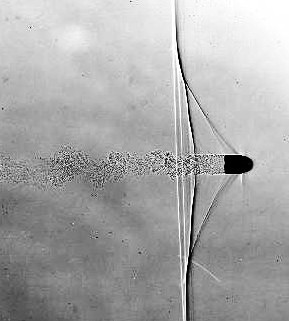Shadowgraph
Shadowgraph is a technique used to visualize fluid flow patterns, heat currents, and other phenomena that affect the density of a medium. It is a simple and ancient method that relies on the interaction between light and the material being studied. The shadowgraph technique is widely used in various fields, including aerodynamics, thermodynamics, and optics, due to its simplicity and effectiveness in providing qualitative information about the phenomena under observation.
Principle
The principle behind the shadowgraph technique is based on the deflection of light rays as they pass through a medium with varying density. When light travels through a medium, its speed changes according to the medium's density; this is known as the refraction of light. In areas where the density of the medium changes, such as in the presence of thermal gradients or fluid flow patterns, the light rays are bent. By projecting these light rays onto a screen, the shadowgraph technique creates visual patterns that correspond to the density variations within the medium. These patterns can be captured and analyzed to study the physical phenomena causing the density changes.
Setup
A typical shadowgraph setup involves a coherent light source, such as a laser or a collimated light beam, the test section containing the medium under study, and a screen or detector to capture the resulting shadowgraph image. The light source illuminates the test section, and the screen captures the shadows and patterns formed by the deflection of light rays due to density variations in the medium.
Applications
Shadowgraphy has a wide range of applications in scientific research and industry. Some of the key applications include:
- **Aerodynamics**: Visualization of shock waves around supersonic aircraft and in wind tunnel tests. - **Combustion Research**: Study of flame fronts and combustion processes. - **Heat Transfer**: Visualization of convection patterns and heat transfer phenomena. - **Fluid Mechanics**: Observation of flow patterns, turbulence, and vortices in fluids.
Advantages and Limitations
The shadowgraph technique offers several advantages, including simplicity, low cost, and the ability to visualize large areas of the test section simultaneously. However, it also has limitations, such as providing only qualitative information and being less sensitive than other optical methods like schlieren photography and interferometry.
Conclusion
The shadowgraph technique remains a valuable tool in the visualization of fluid flow and thermal phenomena. Its simplicity and effectiveness make it an essential method in the fields of aerodynamics, thermodynamics, and optics. Despite its limitations, the shadowgraph continues to be used alongside more advanced techniques to provide a comprehensive understanding of complex physical phenomena.
Transform your life with W8MD's budget GLP-1 injections from $125.
W8MD offers a medical weight loss program to lose weight in Philadelphia. Our physician-supervised medical weight loss provides:
- Most insurances accepted or discounted self-pay rates. We will obtain insurance prior authorizations if needed.
- Generic GLP1 weight loss injections from $125 for the starting dose.
- Also offer prescription weight loss medications including Phentermine, Qsymia, Diethylpropion, Contrave etc.
NYC weight loss doctor appointments
Start your NYC weight loss journey today at our NYC medical weight loss and Philadelphia medical weight loss clinics.
- Call 718-946-5500 to lose weight in NYC or for medical weight loss in Philadelphia 215-676-2334.
- Tags:NYC medical weight loss, Philadelphia lose weight Zepbound NYC, Budget GLP1 weight loss injections, Wegovy Philadelphia, Wegovy NYC, Philadelphia medical weight loss, Brookly weight loss and Wegovy NYC
|
WikiMD's Wellness Encyclopedia |
| Let Food Be Thy Medicine Medicine Thy Food - Hippocrates |
Medical Disclaimer: WikiMD is not a substitute for professional medical advice. The information on WikiMD is provided as an information resource only, may be incorrect, outdated or misleading, and is not to be used or relied on for any diagnostic or treatment purposes. Please consult your health care provider before making any healthcare decisions or for guidance about a specific medical condition. WikiMD expressly disclaims responsibility, and shall have no liability, for any damages, loss, injury, or liability whatsoever suffered as a result of your reliance on the information contained in this site. By visiting this site you agree to the foregoing terms and conditions, which may from time to time be changed or supplemented by WikiMD. If you do not agree to the foregoing terms and conditions, you should not enter or use this site. See full disclaimer.
Credits:Most images are courtesy of Wikimedia commons, and templates, categories Wikipedia, licensed under CC BY SA or similar.
Contributors: Prab R. Tumpati, MD




